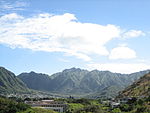Institute for Astronomy (Hawaii)
The Institute for Astronomy (IfA) is a research unit within the University of Hawaiʻi System, led by Doug Simons as Director. IfA main headquarters are located at 2680 Woodlawn Drive in Honolulu, Hawaii, 21°18′27″N 157°48′41″W, adjacent to the University of Hawaiʻi at Mānoa campus. Additional facilities are located at Pukalani, Maui and Hilo on Hawaiʻi island (the Big Island). IfA employs over 150 astronomers and support staff. IfA astronomers perform research into Solar System objects, stars, galaxies and cosmology. The Institute for Astronomy was founded in 1967 to conduct research and to manage the observatory complexes at Haleakalā, Maui and the Mauna Kea Observatory on the summit of Mauna Kea. It has approximately 55 faculty and employs over 300 people.
Excerpt from the Wikipedia article Institute for Astronomy (Hawaii) (License: CC BY-SA 3.0, Authors).Institute for Astronomy (Hawaii)
Woodlawn Drive, East Honolulu Mānoa
Geographical coordinates (GPS) Address External links Nearby Places Show on map
Geographical coordinates (GPS)
| Latitude | Longitude |
|---|---|
| N 21.3075 ° | E -157.81138888889 ° |
Address
Institute for Astronomy
Woodlawn Drive 2680
96813 East Honolulu, Mānoa
Hawaii, United States
Open on Google Maps






